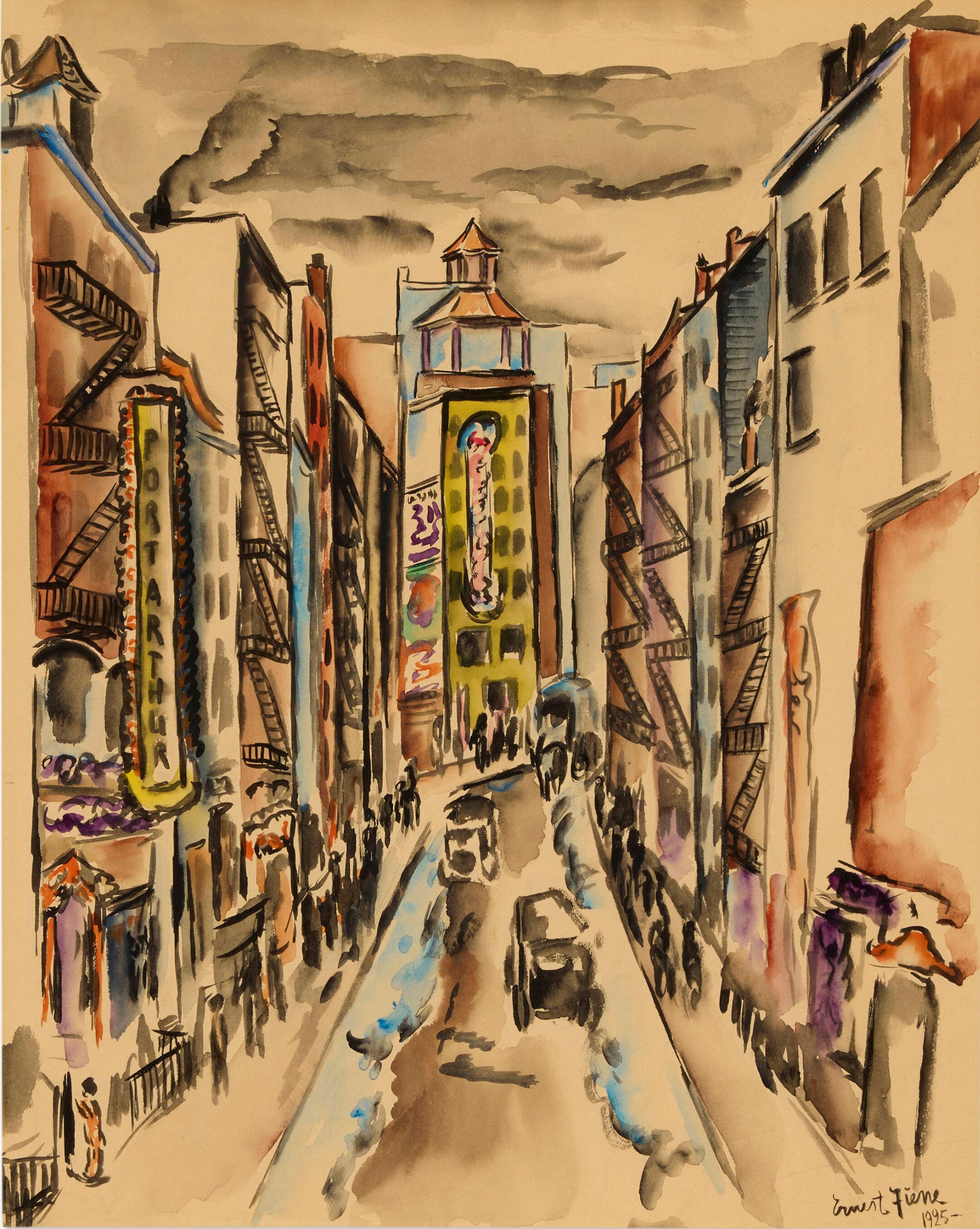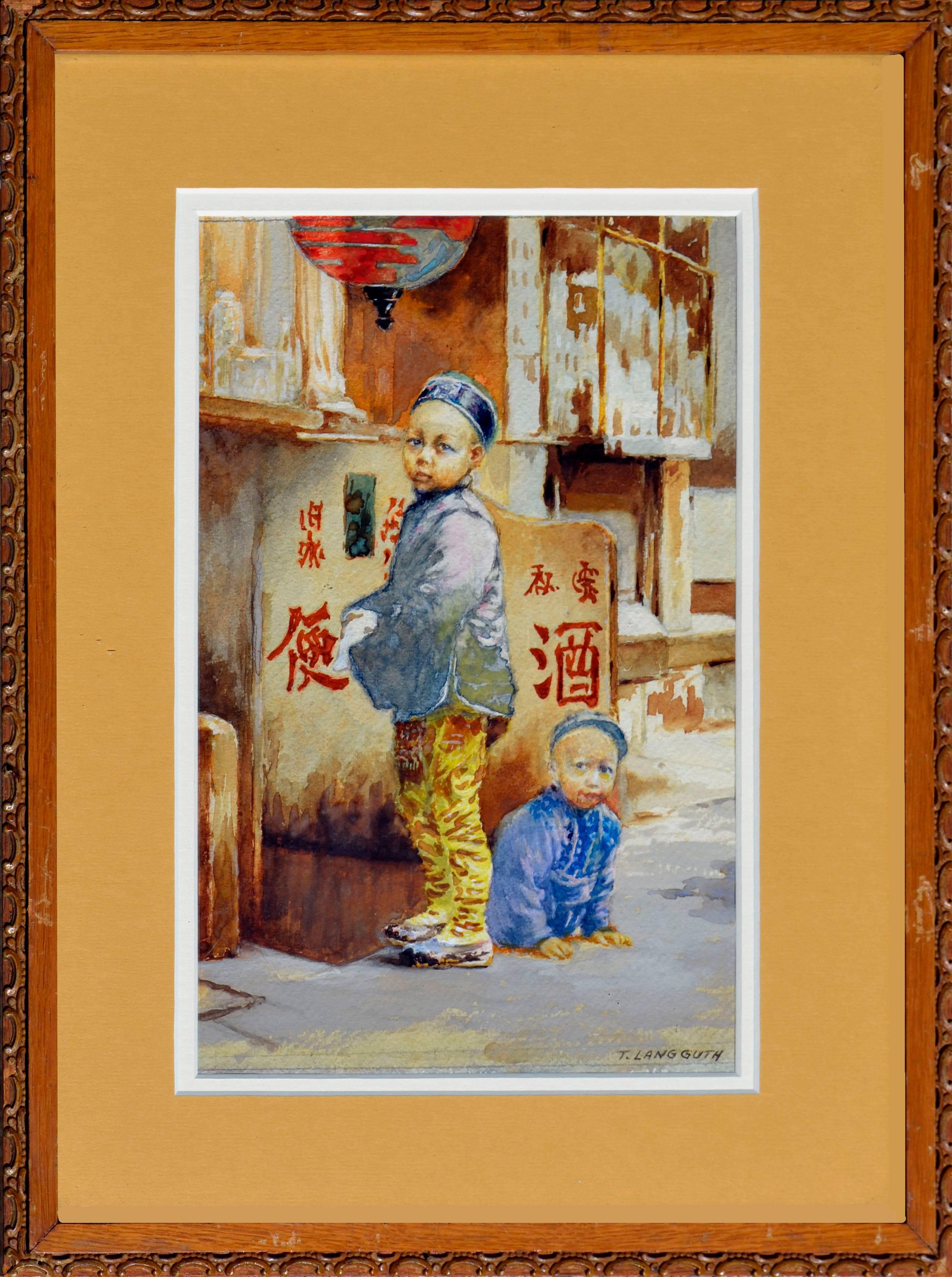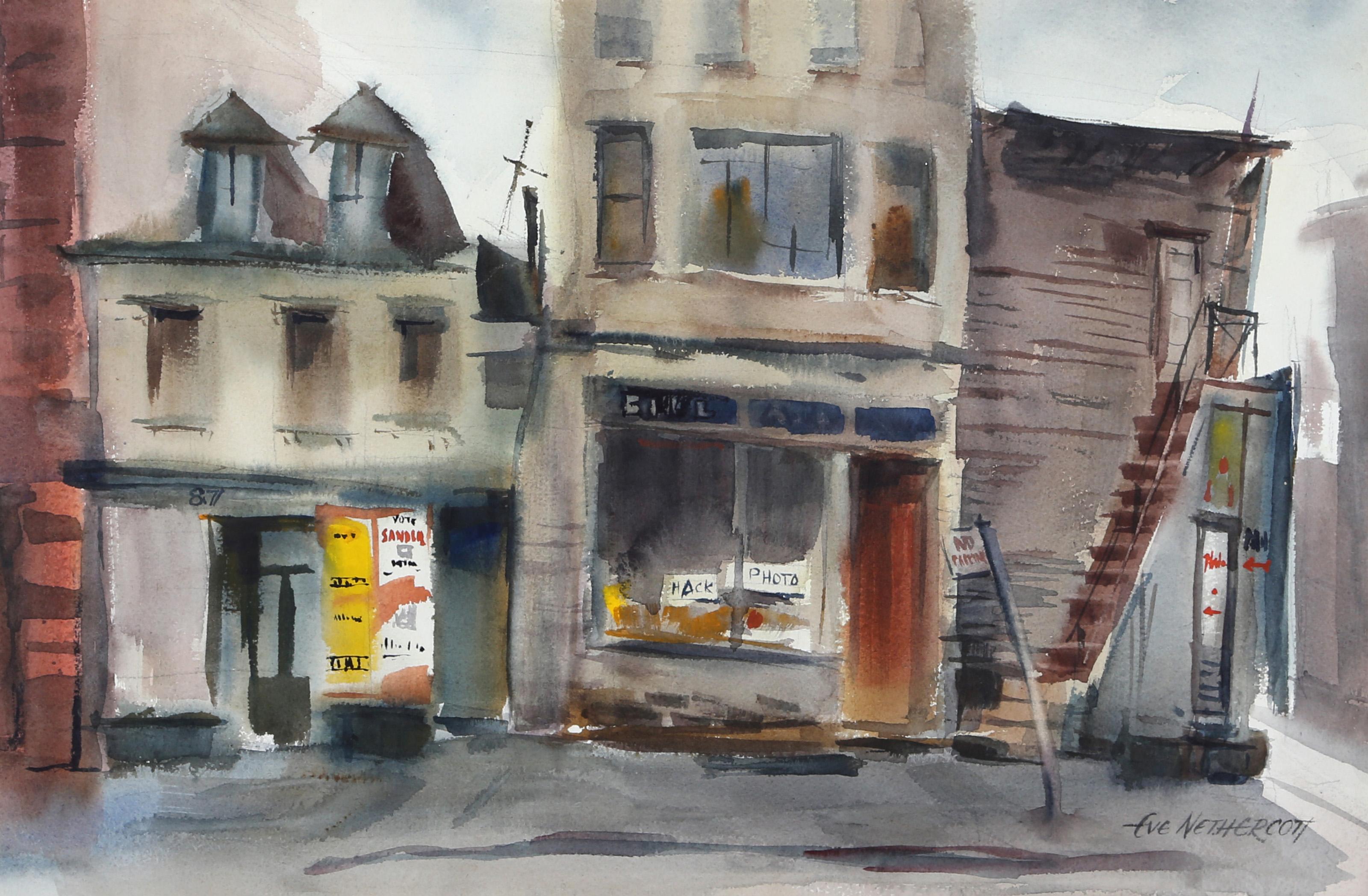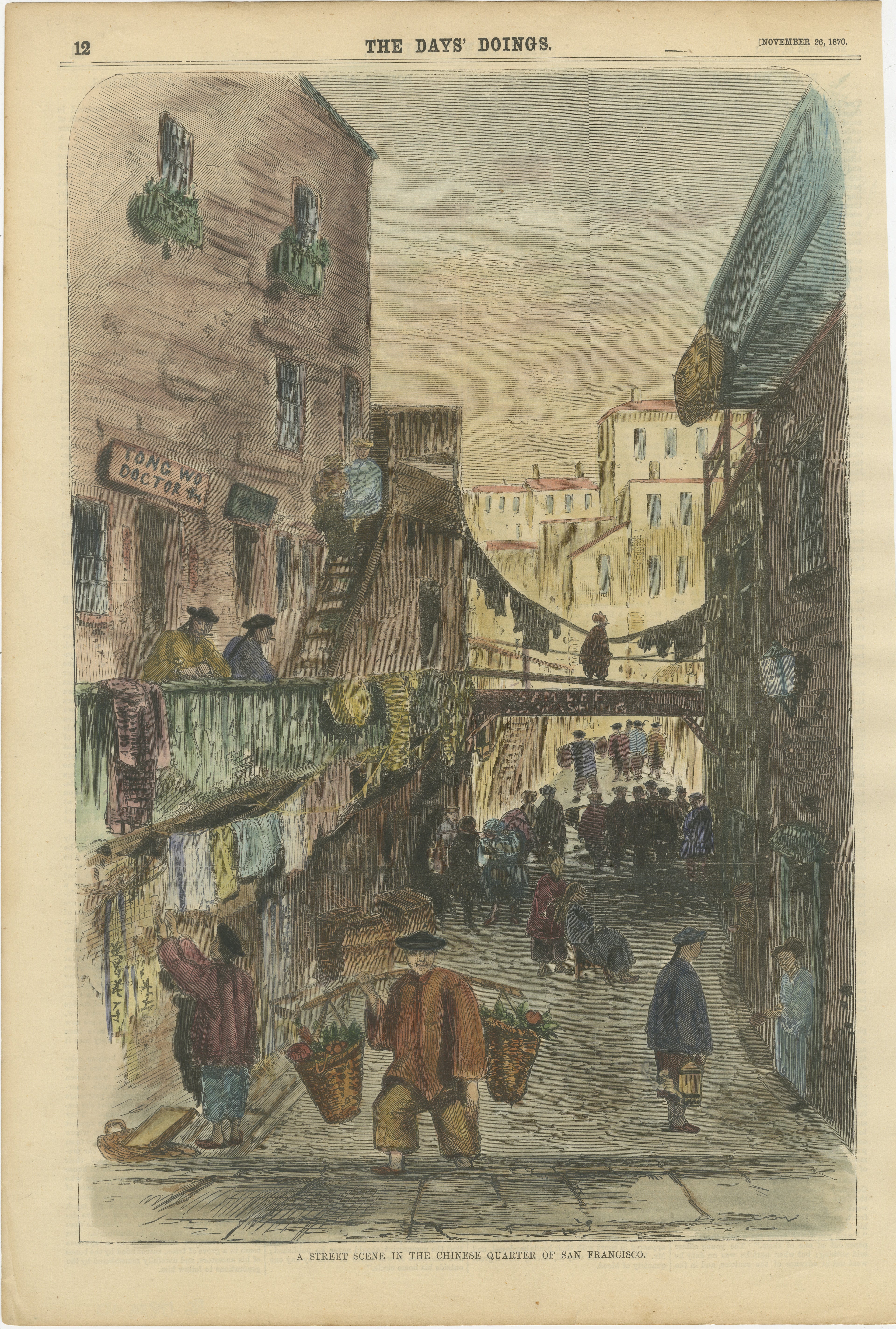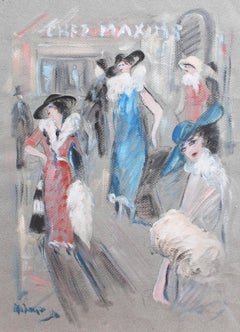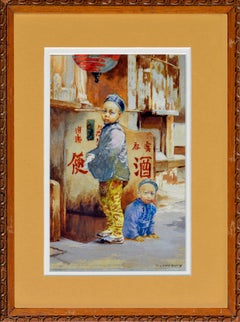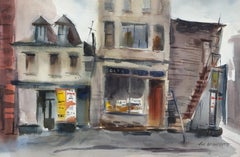Items Similar to Chinatown, San Francisco
Want more images or videos?
Request additional images or videos from the seller
1 of 22
Edward Wilson CurrierChinatown, San Francisco1903
1903
$2,753.59
$3,441.9920% Off
£2,000
£2,50020% Off
€2,355.70
€2,944.6220% Off
CA$3,772.29
CA$4,715.3620% Off
A$4,185.67
A$5,232.0920% Off
CHF 2,192.54
CHF 2,740.6820% Off
MX$51,327.54
MX$64,159.4220% Off
NOK 27,888.40
NOK 34,860.5020% Off
SEK 26,325.46
SEK 32,906.8220% Off
DKK 17,567.93
DKK 21,959.9120% Off
Shipping
Retrieving quote...The 1stDibs Promise:
Authenticity Guarantee,
Money-Back Guarantee,
24-Hour Cancellation
About the Item
'Chinatown, San Francisco', gouache on fine art paper, by Edward Wilson Currier (1903). Spofford Alley in San Francisco's Chinatown is best known for an address (number 36) where Dr. Sun Yat-Sen plotted the overthrow of China's last dynasty. During Prohibition, it was the site of turf battles over local bootlegging and protection rackets. Today it is lined with seniors' community centres. However, the quiet alley livens up in the evenings when a Chinese orchestra strikes up a tune, mah-jongg games begin with a cascade of clicking tiles, and barbers and florists use the pretence of sweeping their doorsteps to gossip. In this artist's depiction, a man smokes a long-stemmed Chinese pipe under the awning and colourful lanterns hanging from the wooden supports while a child looks on. The artwork is interesting from several standpoints including architectural, cultural and historical. Shortly after this work was painted, the neighbourhood was completely destroyed in the 1906 earthquake that levelled most of the city. From 1910 to 1940, Chinese immigrants were detained at the Angel Island immigration station in the San Francisco Bay. To be permitted entry to the United States, thousands of mostly Chinese immigrants crossing the Pacific to San Francisco had to enter through the gauntlet of Angel Island, and were detained for months in a purgatory of isolation. E.W. Currier painted several works in Chinatown from the beginning of the century until about 1915.
The artwork is in good vintage condition and has been newly framed and glazed with museum quality glass (anti-reflective and UV protective). See this listing's accompanying photos to appreciate its condition and aesthetic qualities. We have also included images from the original backing of the painting for your enjoyment. It is signed and dated in the lower right hand corner of the painting: 'E.W. Currier 1903'. Upon request a video of the work may be provided.
About the Artist: Edward Wilson Currier (1857–1918) was an American painter born in Marietta, Ohio. He was educated at the Chicago Academy of Fine Arts and opened a studio in San Francisco, California. He is best known for his oil and watercolour paintings of landscapes, still lifes and maritime scenes.
Dimensions with Frame:
H 47.0 cm / 18.5"
W 39.0 cm / 15.4"
Dimensions without Frame:
H 28.5 cm / 11.2"
W 21.0 cm / 8.3"
- Creator:Edward Wilson Currier (1857 - 1918, American)
- Creation Year:1903
- Dimensions:Height: 18.51 in (47 cm)Width: 15.36 in (39 cm)
- Medium:
- Movement & Style:
- Period:
- Condition:
- Gallery Location:London, GB
- Reference Number:Seller: 08781stDibs: LU61736454372
About the Seller
5.0
Platinum Seller
Premium sellers with a 4.7+ rating and 24-hour response times
Established in 2016
1stDibs seller since 2017
506 sales on 1stDibs
Typical response time: <1 hour
- ShippingRetrieving quote...Shipping from: London, United Kingdom
- Return Policy
Authenticity Guarantee
In the unlikely event there’s an issue with an item’s authenticity, contact us within 1 year for a full refund. DetailsMoney-Back Guarantee
If your item is not as described, is damaged in transit, or does not arrive, contact us within 7 days for a full refund. Details24-Hour Cancellation
You have a 24-hour grace period in which to reconsider your purchase, with no questions asked.Vetted Professional Sellers
Our world-class sellers must adhere to strict standards for service and quality, maintaining the integrity of our listings.Price-Match Guarantee
If you find that a seller listed the same item for a lower price elsewhere, we’ll match it.Trusted Global Delivery
Our best-in-class carrier network provides specialized shipping options worldwide, including custom delivery.More From This Seller
View All'Chinatown San Francisco at Twilight', French School (circa 1950s)
Located in London, GB
'Chinatown San Francisco at Twilight', ink and gouache, diptych on card stock, French School (circa 1950s). This artwork was discovered in Paris, France. The unnamed artist skilfully captured that magical moment at dusk when light is at its most beautiful. The scene is Chinatown, San Francisco in the 1950s. The Far East Café, depicted in this artwork was established in 1920. It is the oldest banquet-style Chinese restaurant in the city. Of course, Chinese cuisine in large cities in America has since moved on from the chop suey...
Category
Mid-20th Century Landscape Drawings and Watercolors
Materials
Ink, Gouache
$1,321 Sale Price
20% Off
Parisian Street Scene
By Roland Dubuc
Located in London, GB
'Parisian Street Scene', watercolour on art paper, by Roland DuBuc (circa 1970s). This artwork is a delightful depiction of a Parisian street which scales the hill to the neighbourhood of Montmartre, the home of the basilica of Sacré-Cœur. DuBuc's artworks serve as a love letter to the city of Paris and are recognised by his incredibly charming style. The signed artwork is in good overall condition and has been newly framed with anti-reflective glass. Please enjoy the many photos accompanying this listing. Upon request a video of the piece may be provided.
About the Artist: Roland DuBuc (1924-1998), French artist, the sixth of 13 children and son of a construction worker. The very precariousness of the family's financial situation forced him to go to work at the age of 14. In extreme poverty, he moved to Rouen where he was lodged by the Salvation Army. During that time he struck up friendships with several artists who gave him advice and taught him techniques of drawing. He moved to other cities later where he met painters including, among others, Fred Pailhès...
Category
1970s Figurative Drawings and Watercolors
Materials
Paper, Watercolor
$1,046 Sale Price
20% Off
'Cherry Blossoms in Japan', French School
Located in London, GB
'Cherry Blossoms in Japan', pencil, ink and gouache on card stock, French School (Mid 20th Century). Cherry blossoms (Sakura) symbolise springtime, a time of renewal and the fleeting...
Category
Mid-20th Century Figurative Drawings and Watercolors
Materials
Ink, Gouache, Pencil
$771 Sale Price
20% Off
Chez Maxim's
By André Meurice
Located in London, GB
'Chez Maxim's', pastel and gouache on fine art paper, by André Meurice (circa 1950s - 60s). The artist depicts the glamorous clientele at the entryway to...
Category
Mid-20th Century Art Nouveau Figurative Drawings and Watercolors
Materials
Pastel, Gouache
$660 Sale Price
20% Off
The Port of Le Havre
By Fred Pailhès
Located in London, GB
'The Port of Le Havre', pencil on art paper, by French artist Fred Pailhès (circa 1950s). Le Havre was only a fishing village until 1517, when Francis I h...
Category
1950s Expressionist Landscape Drawings and Watercolors
Materials
Paper, Pencil
$1,431 Sale Price
20% Off
View of Saint-Médard Church Paris
By Lucien Génin
Located in London, GB
A 'View of Saint-Médard Church, Paris', gouache on art paper, by Lucien Génin (circa 1930s). As viewed from the Rue Mouffetard, the church, which dates from the mid-1400s, continues ...
Category
1930s Landscape Drawings and Watercolors
Materials
Paper, Gouache
$2,643 Sale Price
20% Off
You May Also Like
Chinatown, San Francisco
By Sun Ying
Located in San Francisco, CA
This artwork titled "Chinatown, San Francisco" c.1975 is a watercolor on paper by noted Chinese/American artist Sun Ying, 1919-2016. It is hand signed at the lower left corner by the artist, stamped with the artist red ink stamp at the lower right corner. The artwork size is 15 x 22 inches, framed is 27 x 33.5 inches. It is beautifully custom framed in a wooden gold frame, with gold color spacer and fabric matting. It is in excellent condition.
About the artist.
1919
Sun Ying 孙瑛 ( 1919-2016 ) known as (Sun Dashi 大石) was born on November 8,
in a poor family, in Gaotang Xian, Shandong Province, in China.
1949
Based in Taipei, he devoted himself entirely to painting and influenced the world of art
by creating several painting societies as the Chinese Association of Ink Painting .
Taiwan awarded him the Golden Cup Award.
1960 / 1970
He exhibited his works in Australia, Brazil, Germany, Malaysia and United States.
1974
He went to live in the United States.
1982
After a visit to his family, he returned to China.
1984
With Qi Baishi...
Category
Late 20th Century Realist Figurative Drawings and Watercolors
Materials
Watercolor
"China Town" Ernest Fiene, 1925 Modernist Watercolor on Paper Chinatown Scene
By Ernest Fiene
Located in New York, NY
Ernest Fiene
China Town, 1925
Signed and dated to lower right ‘Ernest Fiene 1925’.
Watercolor on paper
18 1/2 x 14 5/8 inches
Ernest Fiene was born in Elberfeld, Germany in 1894. As a teenager, Fiene immigrated to the United States in 1912. He studied art at the National Academy of Design in New York City from 1914 to 1918, taking day classes with Thomas Maynard and evening classes with Leon Kroll. Fiene continued his studies at the Beaux-Arts Institute of Design in New York from 1916 to 1918, adding classes in printmaking at the Art Students League in 1923.
Fiene began his career as an artist in 1919 with his first exhibition of watercolors at the MacDowell Club arranged by his mentor Robert Henri. In 1923 the Whitney Studio Club mounted a large exhibition of his works. The following year he had an exhibition at the New Gallery in New York, which completely sold out all fifty-two works, including paintings, watercolors, drawings, and etchings. With the proceeds of sales from the New Gallery exhibition, Ernest Fiene and his younger brother Paul, a sculptor, built studios in Woodstock, New York in 1925.
In the early Twenties Ernest Fiene painted mostly landscapes of Woodstock and both the Ramapo and Hudson River Valleys. The first monograph from the Younger Artists Series was published on Fiene in 1922. Published in Woodstock, the series went on to include Alexander Brook, Peggy Bacon, and Yasuo Kuniyoshi. The book reproduced 1 illustration in color and another 27 reproductions in black and white. Around 1925 Fiene became fascinated with the intensity, excitement, and opportunities for color harmonies New York City offered as a subject. His paintings shifted to urban and industrial themes with architecture, industry, and transportation becoming his subjects.
By 1926 Fiene had attracted the dealer Frank K.M. Rehn, who gave him a one-man exhibition that year, which travelled to the Boston Arts Club. C.W. Kraushaar Galleries gave Fiene a one-man exhibition of urban, landscape, portrait, and still life paintings in 1927. Julianna Force, the director of the Whitney Studio Club and first director of the Whitney Museum of American Art, included two of Fiene’s paintings in a fall exhibition in 1928. The Whitney Studio Club showed Fiene’s paintings in a two-man exhibition with Glenn O. Coleman that year and acquired three of Fiene’s paintings. Also in 1928 Fiene became affiliated with Edith Halpert’s Downtown Gallery where he had an exhibition of 20 lithographs in the spring. Fiene sold his house in Woodstock in 1928 to spend more of his time in New York City.
With so many successful exhibitions, Fiene returned to Paris in 1928-29 where he rented Jules Pascin's studio and studied at the Académie de la Grande Chaumière. In France, Fiene painted both landscape and urban subjects developed from ideas influenced by Cubist geometry and the use of flat areas of broad color. Upon returning to New York in 1930, Fiene used this new approach to continue to paint New York skyscraper and waterfront subjects, as well as to begin a series of paintings on changing old New York based on the excavations for Radio City Music Hall and the construction of the Empire State Building. Frank K.M. Rehn Galleries exhibited this series, titled “Changing Old New York,” in 1931. Fiene also has solo exhibitions at Rehn Galleries in 1930 and 1932. Fiene’s oil paintings are exhibited at the Chicago Arts Club in 1930 as well.
Fiene was included in the Museum of Modern Art’s exhibition Painting and Sculpture by Living Americans in December of 1931. Visiting New York, Henri Matisse saw the exhibition and called Fiene’s Razing Buildings, West 49th Street the finest painting he had seen in New York. Fiene had two mural studies from his Mechanical Progress series exhibited at the Museum of Modern Art’s exhibition Murals by American Painters and Photographers in 1932. Fiene sent View from my Window which depicts Fiene working on a lithograph stone while looking out his window to the newly completed Empire State Building to the Carnegie International in 1931. In 1932 Fiene participated in the first Biennial of American Painting at the Whitney Museum and his prints were included in exhibitions at the Downtown Gallery and the Wehye Gallery. In the same year, Fiene was awarded a Guggenheim fellowship to further study mural painting in Florence, Italy.
On his return from Italy in 1933 Fiene re-engaged himself in New York City life and won several public and private mural projects. Fiene resumed his active exhibition schedule, participating in two group exhibitions at the Whitney Museum and a one-man exhibition of recent paintings at the Downtown Gallery in January 1934. In 1933 he purchased a farm in Southbury, Connecticut, which added Connecticut scenes to his landscape subjects. This was also the year Fiene began to spend summers on Monhegan Island, Maine, where he painted seascapes, harbor scenes, and still lifes.
Fiene’s landscape paintings attracted numerous commissions as part of the American Scene movement. Through the fall and winter of 1935-36, Fiene took an extended sketching trip through the urban, industrial, and farming areas of Pennsylvania and West Virginia. Most of the twenty-four Pennsylvania urban and rural paintings from this trip were featured in an exhibition held at the First National Bank in Pittsburgh in October of 1937 by the Pittsburgh Commission for Industrial Expansion. Fiene said of these works that he formed rhythm, opportunity for space and color, and integrity in the Pennsylvania mill and furnace paintings. Fiene received the silver medal for one of the Pittsburgh paintings...
Category
1920s Modern Figurative Paintings
Materials
Paper, Watercolor
China Town San Francisco 1896 - Watercolor on Paper
By Theodore Ernest Langguth
Located in Soquel, CA
China Town San Francisco 1896 - Watercolor on Paper
A vintage watercolor by Theodore Ernest Langguth (German-American, 1861-1952). Presented in a rustic giltwood frame. Signed "T. Langguth" lower right. Watercolor circa 1920-30. Image: 12.5"H x 8.5"W. Painted from the photograph by Arnold Genthe...
Category
1910s American Impressionist Figurative Drawings and Watercolors
Materials
Paper, Watercolor, Pencil
$719 Sale Price
20% Off
Chinatown, Impressionist Watercolor by Eve Nethercott
By Eve Nethercott
Located in Long Island City, NY
Eve Nethercott, American (1925 - 2015) - Chinatown (P4.22), Year: 1961, Medium: Watercolor on Paper, Size: 13.5 x 20.5 in. (34.29 x 52.07 cm), Description: Eve Nethercott's s...
Category
1960s Impressionist Landscape Drawings and Watercolors
Materials
Watercolor
A Street Scene in the Chinese Quarter of San Francisco Published in 1870
Located in Langweer, NL
A Street Scene in the Chinese Quarter of San Francisco- Published in The Days' Doings, November 26, 1870.
Description: This hand-colored engraving, published in *The Days' Doings* on November 26, 1870, presents a vibrant and detailed view of daily life in the Chinese Quarter (Chinatown) of San Francisco during the late 19th century. The scene captures the bustling atmosphere of a narrow street, lined with wooden buildings, hanging laundry, and small businesses serving the local Chinese community.
The foreground features a man carrying two large baskets of produce, balanced on a pole over his shoulders. Behind him, people are seen engaging in various activities—gathering in groups, walking along the street, and conversing on balconies. A wooden sign reading "Tong Wo Doctor" can be seen on the left, advertising a local Chinese medicine shop, while another sign for "Sam Lee, Sam Sing" is displayed above a bridge-like structure connecting two buildings.
The narrow street, laundry lines, and multi-story wooden buildings with balconies give the scene a distinctly urban and immigrant quarter feel, reflecting the growing Chinese immigrant community in San Francisco during this time. The engraving captures both the vibrant energy of this neighborhood and the cultural exchanges occurring in the rapidly expanding city.
About the Publication and Technique:
*The Days' Doings* was a weekly illustrated newspaper that ran from 1870 to 1879, known for its sensationalist coverage of crime, scandals, and interesting stories from both America and Europe. It often depicted lively scenes from everyday life, such as this portrayal of San Francisco’s Chinatown, providing its audience with visual glimpses into different facets of society.
The engraving is produced using a wood engraving technique, where an image is carved into a block of wood for printing. Afterward, the image was hand-colored to add vibrancy to the bustling street scene. These prints were then mass-produced and circulated widely through publications like *The Days' Doings*.
---
Keywords: San Francisco Chinatown 1870, Chinese Quarter San Francisco, *The Days' Doings* November 26, 1870, Chinese immigrant life 19th century, hand-colored wood engraving, Chinatown street scene engraving, Tong Wo Doctor, Sam Lee Sam Sing, 19th-century San Francisco prints...
Category
Antique 1870s Prints
Materials
Paper
$209 Sale Price
20% Off
"Showers Today" San Francisco's Chinatown on an Overcast Day Original Watercolor
Located in Soquel, CA
"Showers Today" San Francisco's Chinatown on an Overcast Day Original Watercolor
A two sided watercolor on Arches paper by San Francisco and Maryland artist Harolod Gretzner (America...
Category
1970s American Modern Figurative Drawings and Watercolors
Materials
Watercolor, Laid Paper
More Ways To Browse
San Francisco Oil Painting
San Francisco City Painting
San Francisco Drawing
Architecture San Francisco
Wilson Antique
Chinese Art Tiles
Barber Sign
Antique Chinese Lantern
Antique Chinese Tiles
E Wilson
Antique Ohio Glass
Antique Paper Lantern
Chinese Painted Tiles
Gossip Painting
Antique Earthquake
Chinese Paper Lanterns
Antique Chinese Games
H Wilson Landscape
